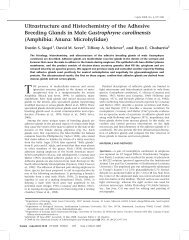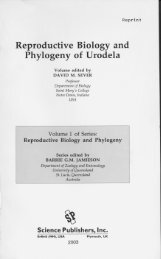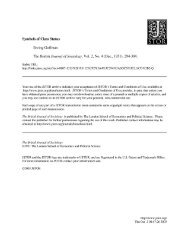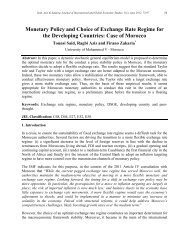Marvelous Facts and Miraculous Evidence in Early Modern Europe ...
Marvelous Facts and Miraculous Evidence in Early Modern Europe ...
Marvelous Facts and Miraculous Evidence in Early Modern Europe ...
Create successful ePaper yourself
Turn your PDF publications into a flip-book with our unique Google optimized e-Paper software.
112 Lorra<strong>in</strong>e Daston<br />
<strong>Facts</strong> <strong>and</strong> <strong>Evidence</strong><br />
of the Royal Society of London <strong>and</strong> the Paris Academie des Sciences were<br />
often such strange ones, for natural philosophy required the shock of<br />
repeated contact with the bizarre, the heteroclite, <strong>and</strong> the s<strong>in</strong>gular <strong>in</strong><br />
order to sunder the age-old l<strong>in</strong>k between "a datum of experience" <strong>and</strong><br />
"the conclusions that may be based on it"; <strong>in</strong> other words, to sunder facts<br />
from evidence.<br />
Thus <strong>in</strong> the course of the sixteenth <strong>and</strong> seventeenth centuries preternatural<br />
phenomena swung from the almost-supernatural extreme of portents<br />
to the almost-natural extreme of Baconian facts. They began as signs<br />
par excellence <strong>and</strong> ended as stubbornly <strong>in</strong>significant. The crucial step <strong>in</strong><br />
this astonish<strong>in</strong>g transformation was the naturalization of preternatural<br />
phenomena. However, it would be a mistake to conclude that Spencer,<br />
Casaubon, <strong>and</strong> others who attacked the portentous <strong>in</strong>terpretation of<br />
prodigies were always or even usually assert<strong>in</strong>g the autonomy <strong>and</strong> <strong>in</strong>violability<br />
of natural laws, a la David Hume. First, these so-called naturalizers<br />
countenanced the most unnatural of natural causes <strong>in</strong> their attempts to<br />
debunk false miracles. Pietro Pomponazzi's De naturalium effectuum causis;<br />
sive, De <strong>in</strong>cantationibus (1556) expla<strong>in</strong>ed putative miraculous cures <strong>and</strong><br />
apparitions by causes almost as wondrous: occult virtues of animals,<br />
plants, <strong>and</strong> humans; astral <strong>in</strong>fluences; the power of the imag<strong>in</strong>ation on<br />
animate <strong>and</strong> <strong>in</strong>animate bodies.54 Bacon was equally will<strong>in</strong>g to grasp at the<br />
imag<strong>in</strong>ation as a natural alternative to a supernatural explanation.<br />
Review<strong>in</strong>g stories about corpses bleed<strong>in</strong>g anew <strong>in</strong> the presence of their<br />
murderers, he commented: "It may be, that this participateth of a miracle,<br />
by God's just judgment, who usually br<strong>in</strong>geth murders to light: but if it be<br />
natural, it must be referred to imag<strong>in</strong>ation."55<br />
Second, the structure of natural causes was not always mechanical or<br />
even determ<strong>in</strong>istic. Spencer, for example, <strong>in</strong>voked the metaphor of natural<br />
law, but so literally that nature, like human legislators, was granted<br />
considerable freedom to make exceptions: "the more private <strong>and</strong> common<br />
Laws of Motion" only hold until superseded by "some more catholick <strong>and</strong><br />
<strong>in</strong>dispensable Laws ... as the Statutes <strong>and</strong> Customs of private Corporations<br />
take place, till their power be suspended by some more catholick <strong>and</strong><br />
<strong>in</strong>forc<strong>in</strong>g Law of State" (DCP, p. 5). Similarly, when he likened nature to<br />
clockwork, it was a mechanism whose "bl<strong>in</strong>d <strong>and</strong> decay<strong>in</strong>g Powers must be<br />
managed <strong>and</strong> perpetually woond up by an H<strong>and</strong> of Power <strong>and</strong> Counsel, or<br />
they will either st<strong>and</strong> still, or perform their motions without time <strong>and</strong><br />
method" (DCP, p. 136).<br />
Thirdly, a natural explanation did not always preclude a preternatural<br />
or supernatural one. The cause of a monstrous birth might be both<br />
54. See Pietro Pomponazzi, De naturalium effectuum causis; sive, De <strong>in</strong>cantationibus<br />
(1556; Hildesheim, 1970).<br />
55. Bacon, Sylva Sylvarum: or, A Natural History <strong>in</strong> Ten Centuries [1627], <strong>in</strong> The Works of<br />
Francis Bacon, 4:516-17.







